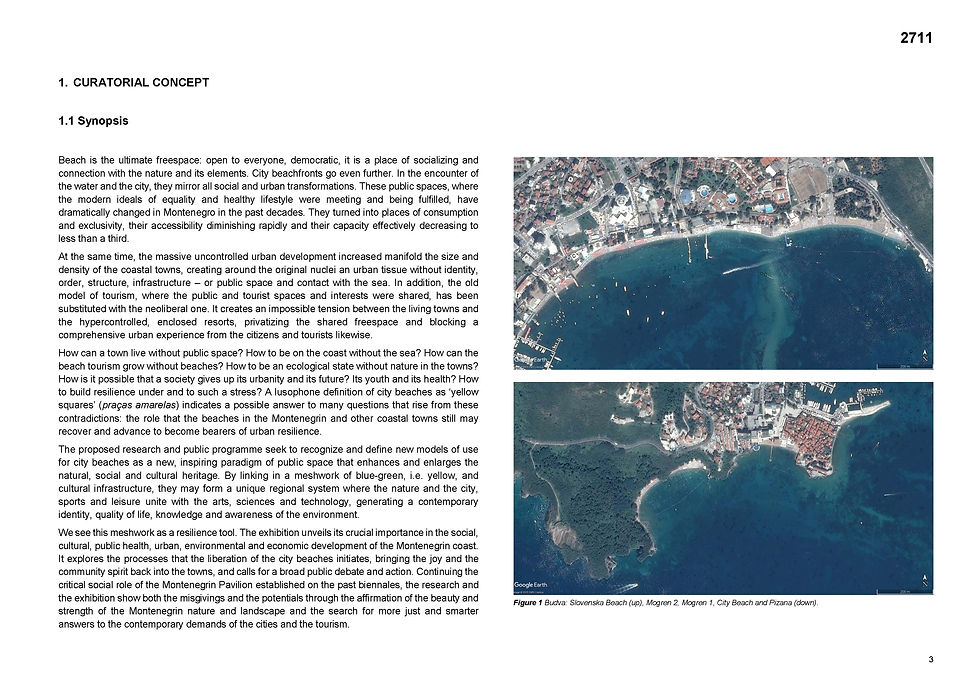BEACH AS A CITY
Resilience between Uncontrolled and Hyper-Controlled
A Research and Exhibition Concept for the Montenegrin Pavilion at the 16th Venice Architecture Biennale 2018
Beach is an ultimate freespace: opened to everyone, democratic, it is a place of socializing and connecting with nature and its elements. Urban beaches go even further. In the encounter of the water and the city, they mirror all social and urban transformations. These public spaces, where the modern ideals of equality and healthy lifestyle were meeting and being fulfilled, have dramatically changed in Montenegro in the past decades. They turned into places of consumption and exclusivity, their accessibility diminishing rapidly and their capacity effectively decreasing to less than a third.
At the same time, the massive uncontrolled urban development increased manifold the size and density of the coastal towns, creating around the original nuclei an urban tissue without identity, order, structure, infrastructure – nor public space. In addition, the old model of tourism, where the public and tourist spaces and interests were shared, has been substituted with the neoliberal one. It creates an impossible tension between the living towns and the hypercontrolled, enclosed resorts, privatizing the shared freespace and blocking a comprehensive urban experience from the citizens and tourists likewise.
How can a town live without public space? How to be on the coast without the sea? How can the beach tourism grow without beaches? How to be an ecological state without nature in the towns? How is it possible that one society gives up its urbanity and future? Its youth and its health? How to build resilience in (and to) such a situation? A lusophone definition of urban beaches as ‘yellow squares’ (praças amarelas) indicates a possible answer to many questions that arise from these contradictions: the role the beaches in the Montenegrin coastal towns still may recover and advance to become bearers of urban resilience.
The proposed research and public programme seek to recognize and define new models of use for urban beaches as a new, inspiring paradigm of public space that enhances and enlarges the natural, social and cultural heritage. Linking in a meshwork of blue-green - or yellow - and cultural infrastructure, they may form a unique regional system where the nature, sports and leisure mix with the arts, sciences and technology, generating a contemporary identity, quality of life, knowledge and awareness of the environment. We see this meshwork as a resilience tool. The exhibition unveils its crucial importance in the social, cultural, public health, environmental and economic development of the Montenegrin coast. It explores the processes that the recovery of the urban beaches initiates, bringing the joy and the community spirit back into the town, and calling for a broad public debate and action.
The exhibition design follows and supports closely the research content, stressing the cultural and educational role that the beaches need to recover through a coordinated action of the landscape, architecture and art. Same as the investigation explores the possibilities to bring the beach into the city and the city life to the beach, the exhibition acts both through an interiorization of the city - and the beach - into the exhibition space of the Pavilion, and through an exteriorization of the exhibition content in the city. It evokes the concept of “creleisure,” i.e. creative leisure, opposite to the passive leisure of Montenegrin beaches, mass entertainment or even traditional museum culture, defined half a century ago by Hélio Oiticica. This Brazilian artist challenged with his work the very concept of the museum, art gallery and exhibition. The exhibition design is an homage to the synthesis of art, space and life materialized in his interactive pop-up beaches and labyrinthine structures that translate nowadays in the notions of “relational aesthetics” and “audience engagement”, challenging them too. That low tech, meta-level of the exhibition serves as a spatial frame for digital prints and video projections of the research content.
Mila Nikolić
Location:
Venice, Italy
Year:
2018
Category:
interior, exhibition design, curating
Type:
competition
Size:
100 m2 interior + 40 m2 courtyard
Client:
Ministry of Sustainable Development and Tourism of Montenegro
Arch. office:
MNA
Status:
idea
Project team:
Mila Nikolić


